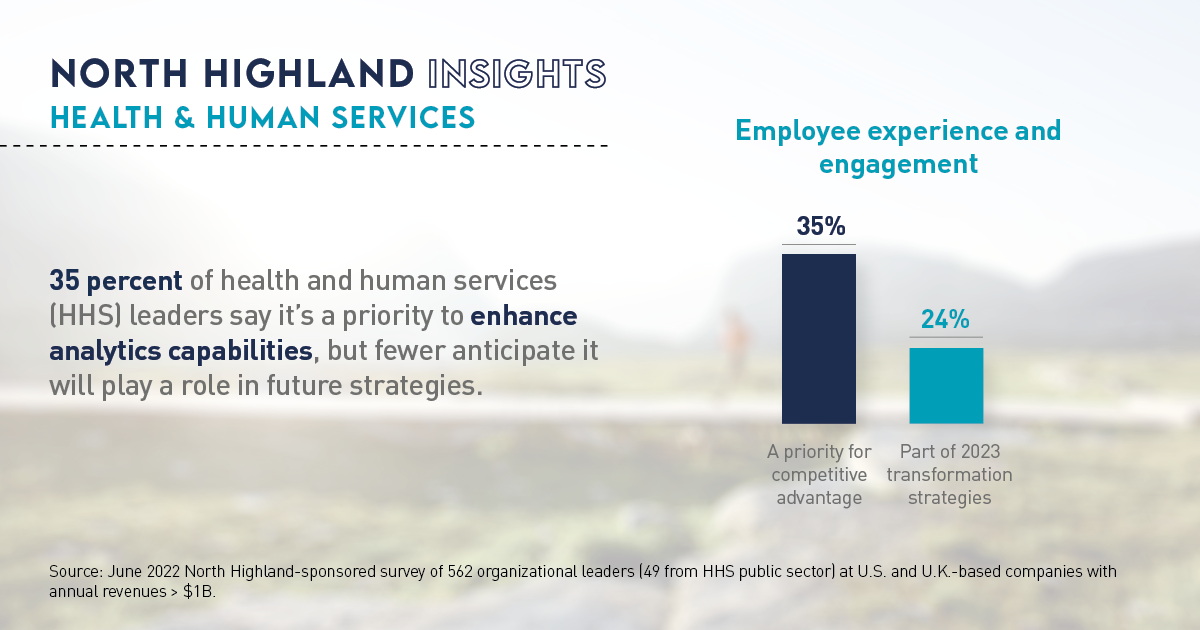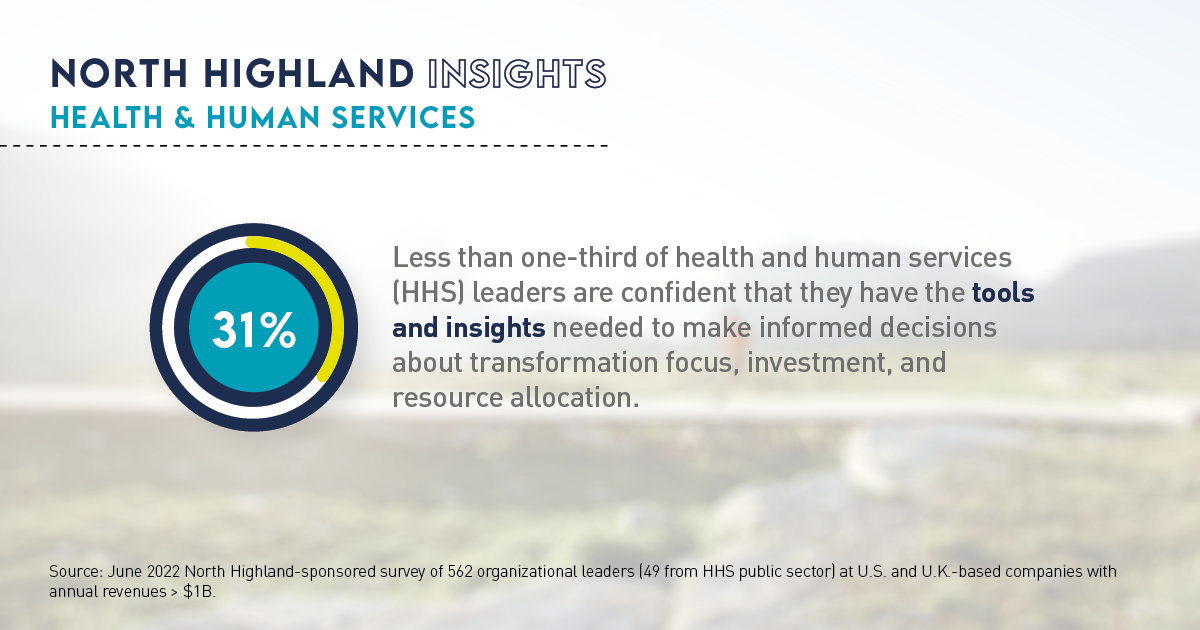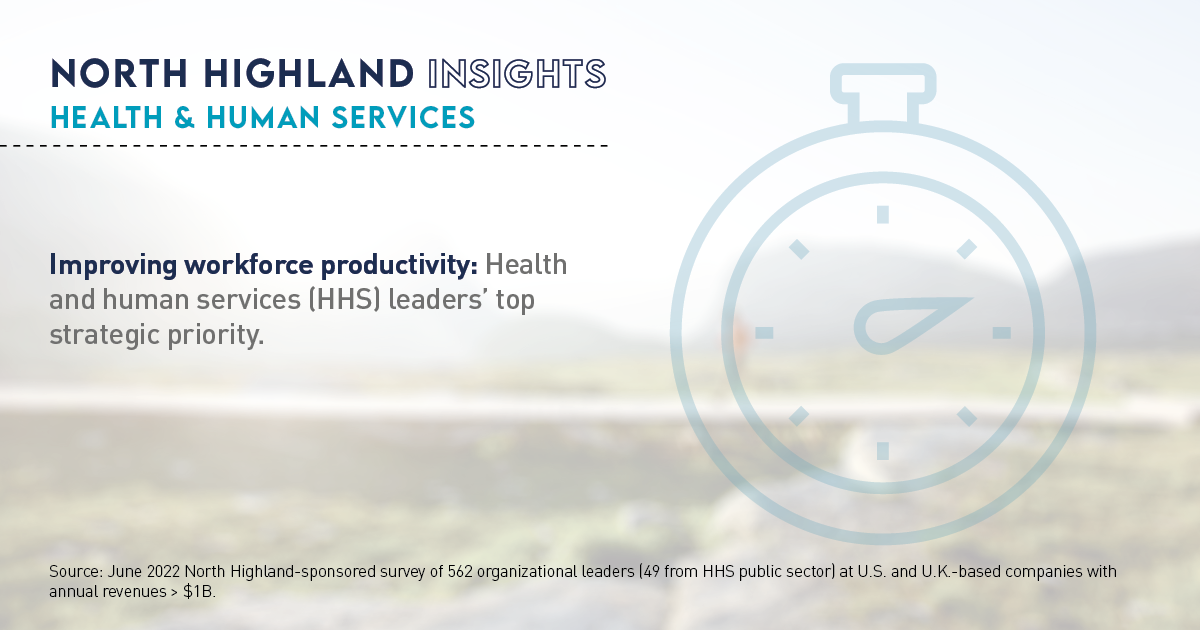In June 2022, North Highland connected with over 560 leaders across key industries—including financial services, healthcare, health and human services, life sciences, and transportation—to better understand the trends and challenges confronting today’s businesses as they navigate the end-to-end transformation journey. What we discovered is a desire to build more adaptive operations to power continuous transformation; a need for greater alignment across employees and leadership teams around transformation strategy; and opportunities to integrate data and analytics into every step for greater success. Amidst the transformation that is reshaping our economies and societies, every business has a clear path to a better vantage point. In this blog series, we'll uncover what it takes for each industry to maximize its transformation potential.
Health and human services (HHS) leaders recognize the importance of designing flexible transformation strategies to keep up with the many changes that are sure to come in the next few years. As an industry that has acutely felt the strain of the COVID-19 global pandemic, this is no surprise. Industry leaders have spent the last few years constantly shifting gears and adapting to reimagine constituent experiences, address complex system modularity, and achieve other transformation initiatives.
Yet, our June 2022 survey of 49 HHS leaders highlights an opportunity for HHS agencies to further infuse flexibility—particularly into operations—to support future aspirations. The path to greater flexibility for HHS lies in two key opportunities:
- Leadership and employee alignment around transformation strategy; and
- The use of data and analytics (D&A) capabilities to power the end-to-end transformation journey.
In this blog, we’ll take you through these trends and more. We’ll explore the steps HHS leaders can take to realize the benefits of data and leadership alignment across the transformation journey. Your next vantage point? Transformation success.
YOUR NEXT VANTAGE POINT: DATA-INFORMED STRATEGY DESIGN
The findings from our survey suggest that HHS leaders are using data in fits and starts throughout the transformation journey. Industry respondents know that data is a priority this year, and they are using it to deliver on transformation strategy, but it plays a lighter role in strategic alignment, planning, and design, and there are still opportunities to maximize the potential of data in transformation delivery.
While 39 percent of leaders say they utilize D&A to define a clear transformation strategy, that’s 25 points lower than the average of all industries we surveyed for this research. And though 35 percent of leaders say enhancing analytics capabilities is a priority for gaining a competitive advantage this year, only 24 percent of industry leaders expect to actually follow through on this effort as part of their transformation strategy in 2023.

Respondents from the industry also tend to miss opportunities to better leverage both data and technology when designing transformation strategies. In fact, a mere six percent of respondents say they use analytics when designing transformation strategies.
 There is also room to improve the use of D&A to deliver transformation strategies. While 37 percent say D&A is one of the top five most effective techniques for delivering transformation strategies, 53 percent of leaders say inadequate data capabilities is a barrier to transformation delivery.
There is also room to improve the use of D&A to deliver transformation strategies. While 37 percent say D&A is one of the top five most effective techniques for delivering transformation strategies, 53 percent of leaders say inadequate data capabilities is a barrier to transformation delivery.
When it comes to the workforce, HHS leaders are making good use of data: 61 percent of respondents say they leverage Voice of Employee data to tap into the value of people in their transformation efforts. Sixty-five percent of industry leaders say one of the most valuable aspects of D&A is using it to address employee and workforce needs.
Despite a strong emphasis on employee-related insights, the application of Voice of Customer (VoC) data is much lower than the all-industry average.
YOUR FIRST STEPS
Data is critical at every step of the transformation process, from design to delivery to measurement. Leaders in HHS must develop a more complete picture of the value that data can bring to transformation. These are your first steps:
- Weave insights across your transformation journey with a digital core. Sixty-seven percent of leaders are only somewhat confident that they have the tools and insights to make informed decisions when embarking on a transformation. This tells us there is room for leaders in the industry to enhance their data and technology architecture and supporting organizational capabilities—what we call a digital core—across the business. Design an integrated digital core that brings together the technology and operational capabilities needed to infuse analytics into strategy definition, design, and delivery. By establishing high-performance and scalable data environments, you’ll have access to real-time insights and advanced analytics. With a strong digital core, you can sense change through data and respond to it effectively through organizational capabilities.
- Empower teams with data-driven decision-making. Establishing the infrastructure to capture the right data is a good first step. But your people must be able to do something with the data to harness its power. That’s why it’s critical to build employees’ data literacy. This is the process of creating a solid foundation of internal analytics competencies and capabilities. With data literacy, employees are equipped to make informed decisions about focus, investment, and resource allocation—something that 69 percent of those we surveyed acknowledge is the most valuable use of data and digital capabilities. When employees develop the skills to turn data into meaningful insights, it can be transformational. For example, just 27 percent of HHS leaders say they leverage VoC insights to design transformation strategies, and only six percent are using VoC to track transformation success. Improved data literacy increases your ability to take feedback and insights from your customers, uncover issues, and illuminate solutions you may not be able to find otherwise. This is valuable in helping leaders and employees make smart decisions on the transformation journey.
YOUR NEXT VANTAGE POINT: OPERATIONS STRONG ENOUGH TO FLEX
When pursuing change, the muscle for adaptability is key among the HHS leaders we surveyed. As they move toward 2023, HHS leaders plan to build flexibility into their transformation strategies by establishing adaptive operations.
More so than other industries we surveyed, HHS respondents say they are keen on building operating models with the muscle for frequent, small changes that support a flexible strategy (78 percent cited this as a technique they use). The operating model serves as the foundation for transformation and portrays how the essential components of your business—including people, structure, processes, governance, and technology and data—come together to make change happen.

HHS leaders also factor in operational inefficiencies when defining their transformation strategy (33 percent). When designing transformation strategies, 59 percent of HHS respondents say operational leadership has a seat at the table—more so than all other functions. In other industries we surveyed, operations was frequently left out.
The industry is also focused on integrating flexibility and adaptability into ways of working, a key aspect of operations: 65 percent of HHS leaders agree that flexible ways of operating and working are a crucial aspect of successful change. HHS leaders know teams must remain nimble, efficient, and productive in order to deliver on strategy and respond to changing constituent needs.

Though flexibility is top of mind for HHS leaders, they are less confident that they can measure how well they are adapting: Only 29 percent say they have the ability to measure the degree to which they are incorporating flexibility and adaptability into their daily practices.
YOUR FIRST STEPS
To build adaptive operations, consider these foundational steps:
- Implement agile practices to build more “forgiveness” into your operating model. Don’t think of your operating model as a final destination but something to continually reassess and evolve. This is a mindset shift, and it’s also one that requires you to build a test-and-learn culture among your workforce to support agile operations.
- Apply design, systems, and scenario thinking to build adaptive operations. When designing flexible strategies, less than half of HHS leaders we surveyed say they use scenario thinking; only 29 percent employ design thinking, and a mere four percent use systems thinking. Looking past each of these techniques in isolation, leaders can achieve even greater impact through integration. Together, design, systems, and scenario thinking (DSS Thinking) help you infuse more flexibility into your operating model. With DSS Thinking, you’ll gain greater transparency and a better understanding of how your organization operates as a connected system. That visibility can help you pinpoint opportunities to enhance your operating model in better support of your transformation objectives. As you apply DSS Thinking, consider ways you can modernize your operations and operational infrastructure to flex with change. Only 14 percent of leaders we surveyed expect to modernize operations as they define their transformation strategies, and only four percent anticipate actually doing so as part of their transformation strategy in 2023. In other words, operational modernization is an untapped opportunity—one that promises a competitive edge to those that exploit it.
- Rethink your KPIs and integrate insights into your operational strategy. It may be time to integrate new KPIs into your measurement mix. Measuring the success of your transformation strategy means moving beyond your traditional KPIs around budgets, revenue, and timelines. To measure flexibility and adaptability, including among your operations, consider KPIs like speed to market. Utilize data and digital capabilities to assess, enhance, and continuously improve operations. By integrating insights into operational strategy, you can make decisions that support continuous, incremental improvement and, in turn, more predictable value realization.
YOUR NEXT VANTAGE POINT: ORGANIZATIONAL ALIGNMENT
It’s clear from our research that HHS agencies have an opportunity to focus on leadership alignment heading into 2023—and that will require a mindset shift about the impact of alignment on transformation success.
Nearly all HHS leaders believe leadership alignment is important or somewhat important to transformation strategy (96 percent), but 63 percent admit this is something they frequently struggle to achieve. Those we surveyed say they are attempting to align leaders with coaching (80 percent), but a lack of clarity around both future-state roles (51 percent) and transformation strategy (47 percent) are standing in the way.
Part of the challenge may be that driving alignment among leadership teams is not top of mind when setting transformation plans: Just 16 percent of HHS leaders believe improving leadership alignment is a priority when defining their transformation strategy and just two percent say they consider leadership alignment when designing strategy. While balancing speed to market and leadership alignment can be tricky, waiting to bring leaders on board until after the strategy has been developed can stymie your transformation's potential.

Lack of clarity and alignment at the top will inevitably trickle down to front-line employees. In fact, lack of clarity at the top has a direct impact on employee alignment, too: Poor communication from leadership was cited by 51 percent of leaders as the top barrier to employee alignment.
YOUR FIRST STEPS
These are your first steps to overcoming the obstacles to alignment to enhance transformation outcomes:
- Let data help you make the case for change and guide your priorities. Bring leadership stakeholders together to evaluate customer, workforce, and operational data and align on the value drivers that are most important in the context of your shared transformation vision and strategy. The result? Clarity and alignment on priorities. Only 16 percent of industry leaders say they utilize data and analytics to make the case for change, a technique that, when leveraged effectively, can help drive leadership alignment around transformation strategy. Data can help leadership teams define priorities, goals, objectives, and targets that can later be evaluated to measure transformation success. With transformation goals in place, data can help guide how you prioritize efforts to get the most value out of your transformation strategy. Data visualization, via compelling data stories, scorecards, and dashboards, helps you glean high-quality analytics from clean, secure data, and move quickly from insight to action.
- Establish a Transformation Value Office (TVO). Govern your transformation with a structure that connects strategy to delivery and assures alignment across the end-to-end journey. Currently, just 18 percent of HHS leaders say they establish change structures, like a TVO, to tap into the value of people in their transformation efforts. The TVO helps bring all leaders and teams together around a shared vision and transformation approach that sustains alignment.
- Make coaching collaborative. HHS leaders frequently use leadership coaching to work toward alignment. However, if coaching takes place after the design phase of transformation, it may feel more “informative” rather than serve as an invitation for leaders to participate in and help define the change process. Bring leaders to the table early in your transformation, during the design phase, and make the coaching process a collaborative one. Ensure that coaching integrates insights regarding how to communicate with employees about the transformation process—aligned leaders will be some of your strongest allies in successful transformation.
